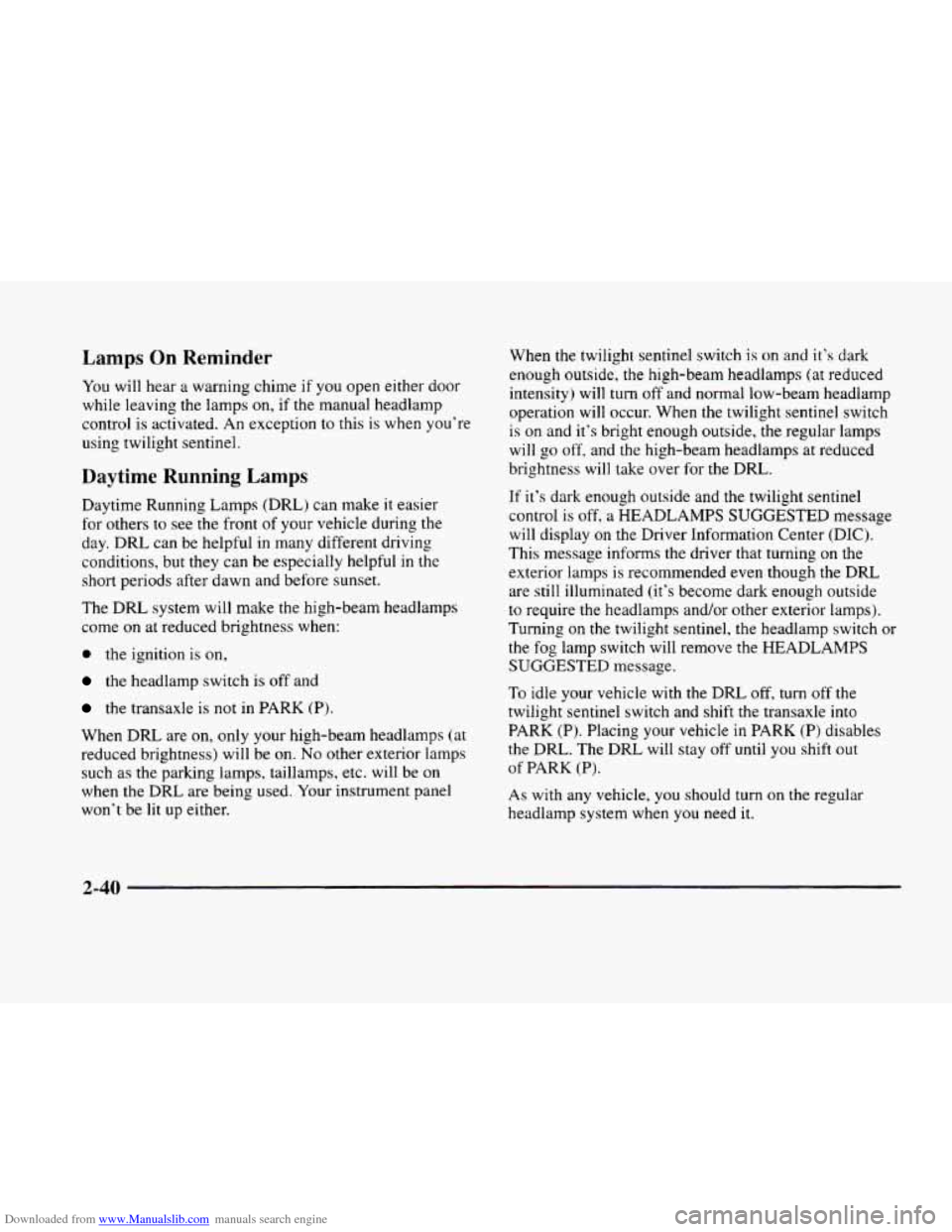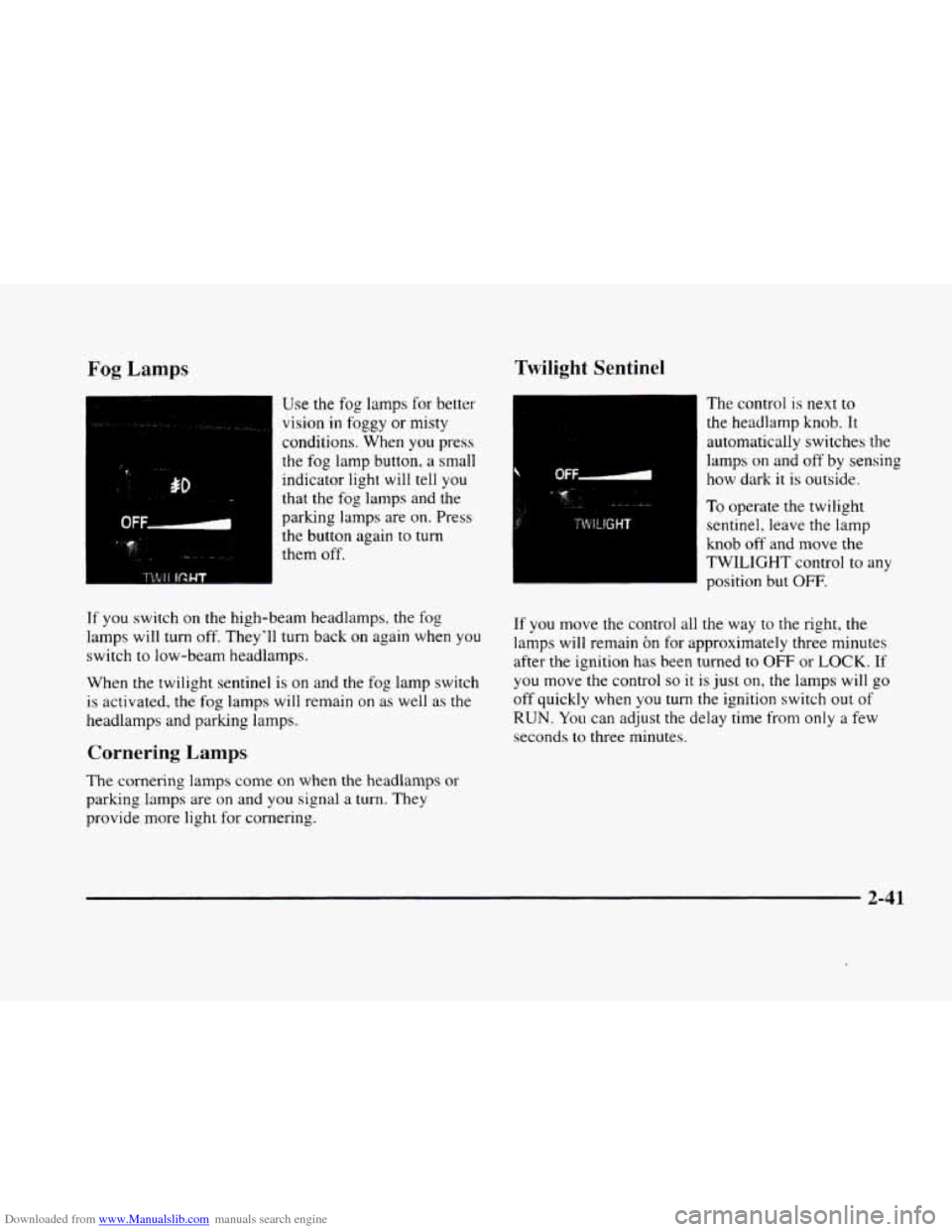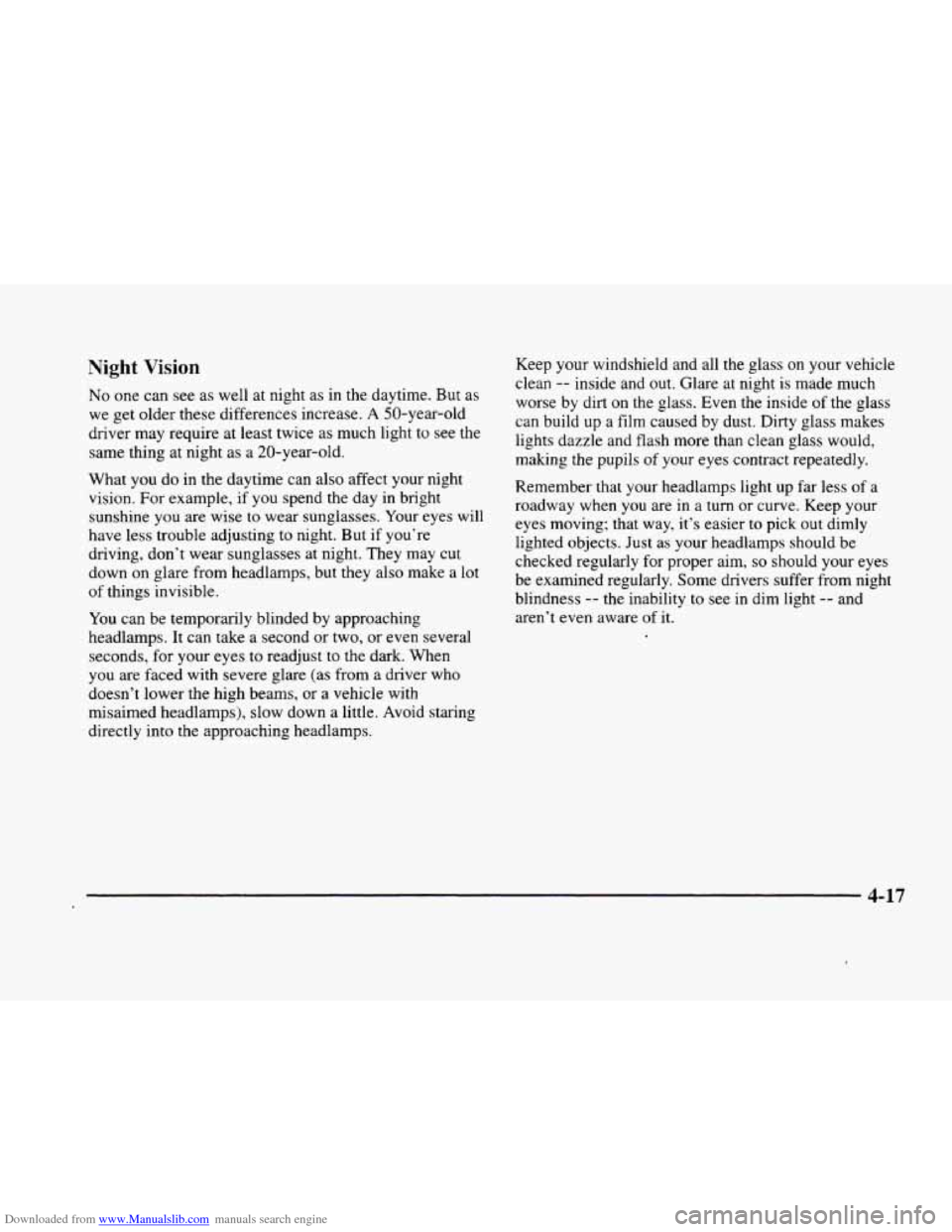1998 CADILLAC ELDORADO low beam
[x] Cancel search: low beamPage 103 of 380

Downloaded from www.Manualslib.com manuals search engine Arrows that flash rapidly when signaling for a turn or
lane change may be caused by a burned-out signal bulb.
Other drivers won’t see
the turn signal.
Replace burned-out bulbs
to help avoid possible
accidents. Check the fuse
(see “Fuses and Circuit
Breakers”
in the Index) and for burned-out bulbs if
the arrow fails to work when signaling a turn.
Headlamp High/Low Beam Changer
Pull the turn signal lever
all the way toward
you and
then release it
to change the
headlamps from low beam
to high or from high beam
to low.
This light
on the instrument panel will be on, indicating
high beam usage.
Flash-To-Pass
This lets you use the high-beam headlamps to signal
the driver in front
of you that you want to pass.
Pull the
turn signal lever toward you to use. When
you do:
0
0
0
If the headlamps are either off or in the Daytime
Running Lamps
(DRL) mode, the high-beam
headlamps will turn
on. They’ll stay on as long
as you hold the lever there. Release the lever to
turn them off.
If the headlamps are
on low beam, they will shift to
high beam and stay there. Pull the lever toward you
to return to low beam.
If the headlamps are
on high beam, they will switch
to low beam.
To return to high beam. pull the lever
toward you.
2-33
Page 110 of 380

Downloaded from www.Manualslib.com manuals search engine Lamps On Reminder
You will hear a warning chime if you open either door
while leaving the lamps on, if the manual headlamp
control is activated. An exception to this is when you’re
using twilight sentinel.
Daytime Running Lamps
Daytime Running Lamps (DRL) can make it easier
for others to see the front
of your vehicle during the
day. DRL can be helpful in many different driving
conditions, but they can be especially helpful in the
short periods after dawn and before sunset.
The
DRL system will make the high-beam headlamps
come
on at reduced brightness when:
0 the ignition is on,
the headlamp switch is off and
the transaxle is not in PARK (P).
When DRL are on, only your high-beam headlamps (at
reduced brightness) will be on. No other exterior lamps
such as the parking lamps, taillamps, etc. will be
on
when the DRL are being used. Your instrument panel
won’t be lit up either. When
the twilight sentinel switch is on and it’s dark
enough outside, the high-beam headlamps
(at reduced
intensity) will
turn off and normal low-beam headlamp
operation will occur. When the twilight sentinel switch
is on and it’s bright enough outside, the regular lamps
will go
off, and the high-beam headlamps at reduced
brightness will take over for the DRL.
If it’s
dark enough outside and the twilight sentinel
control is off,
a HEADLAMPS SUGGESTED message
will display on the Driver Information Center (DIC).
This message informs the driver that turning on the
exterior lamps
is recommended even though the DRL
are still illuminated (it’s become dark enough outside
to require the headlamps and/or other exterior lamps).
Turning on the twilight sentinel, the headlamp switch
or
the fog lamp switch will remove the HEADLAMPS
SUGGESTED message.
To idle your vehicle with the DRL off, turn off the
twilight sentinel switch and shift the transaxle into
PARK (P). Placing your vehicle in PARK
(P) disables
the DRL. The
DRL will stay off until you shift out
of PARK (PI.
As with any vehicle, you should turn on the regular
headlamp system when
you need it.
2-40
Page 111 of 380

Downloaded from www.Manualslib.com manuals search engine Fog Lamps
Use the fog lamps for better
vision
in foggy or misty
conditions. When
you press
the
fog lamp button, a small
indicator light will tell you
that the fog lamps and the
parking
lamps are on. Press
the button again to
turn
them off.
If you switch on the high-beam headlamps. the fog
lamps will turn off. They'll turn back on again when
you
switch to low-beam headlamps.
When the twilight sentinel is on and the fog lamp switch
is activated. the fog lamps will remain on as well as the
headlamps and
parking lamps.
Cornering Lamps
The cornering lamps come on when the headlamps or
parking lamps are on and you signal a turn. They
provide more light for cornering.
Twilight Sentinel
The control is next to
the headlarnp knob. It
automatically switches the
lamps
on and off by sensing
how dark
it is outside.
To operate the twilight
sentinel, leave the lamp
knob
off and move the
TWILIGHT control to any
position but
OFF.
If you move the control all the way to the right, the
lamps will remain on for approximately three minutes
after the ignition has been turned
to OFF or LOCK. If
you move the control so it is just on, the lamps will go
off quickly when you turn the ignition switch out of
RUN. You can adjust the delay time from only a few
seconds
to three minutes.
2-41
Page 152 of 380

Downloaded from www.Manualslib.com manuals search engine EXT LIGHTS AT UNLOCK: Exterior lamps (parking
lamps, taillamps, sidemarker lamps, license plate lamps,
low-beam headlamps, etc.) turn
on when the unlock
button
on the remote keyless entry transmitter is pressed
and
it is dark outside. These lamps stay on for about 20
seconds or until the key is turned OFF.
The prompts listed here appear in the same order as
displayed on
the Driver Information Center (DIC).
FEATURE
ON appears when a yes response is made
and FEATURE OFF appears with a no response. To
skip
to the next personalization feature (REMOTE
RECALL MEMORY), press the
INFO button.
Remote Recall Memory (If Equipped with
Memory Personalization)
Memory settings that have been previously programmed
(climate control settings,
radio preset settings, exterior
lighting choices, remote confirmation choices and
programmable automatic door lock choices) can be
recalled by using the remote keyless entry transmitter or
by placing the key in your vehicle’s ignition. Before
you begin
programming, make sure that your
vehicle’s ignition
is in RUN. To begin programming,
press the
INFO and INFO RESET buttons at the same
time for about two seconds. As mentioned, remote recall
memory
is the third feature to appear. To skip past the
first two personalization features, press the
INFO button.
When REMOTE RECALL MEMORY appears, the
driver is able to recall memory settings when the unlock
button on the remote keyless entry transmitter is
pressed. Press
the TRIP RESET button to select or press
the
INFO RESET button to answer no and to continue
on to the next prompt. FEATURE ON displays when a
yes response
is made.
If
a no response was made, the KEY IN RECALL
MEMORY prompt will’ show next.
This choice recalls
memory settings when the key is placed
in your
vehicle’s ignition. FEATURE
ON displays for a yes
response, and FEATURE
OFF for a no response. A yes
or
no response is required.
2-82
Page 215 of 380

Downloaded from www.Manualslib.com manuals search engine Night Vision
No one can see as well at night as in the daytime. But as
we get older these differences increase.
A 50-year-old
driver may require at least twice as much light to see the
same thing at night as a 20-year-old.
What you do in the daytime can also affect your night
vision. For example, if you spend the day in bright
sunshine you
are wise to wear sunglasses. Your eyes will
have less trouble adjusting to night. But if you’re
driving, don‘t wear sunglasses at night. They may cut
down on glare from headlamps, but they also make a lot
of things invisible.
You can be temporarily blinded by approaching
headlamps. It can take a second or two, or
even several
seconds, for your eyes
to readjust to the dark. When
you are faced with severe glare (as from a driver who
doesn’t lower the high beams, or a vehicle with
misaimed headlamps), slow down a little. Avoid staring
directly into the approaching headlamps. Keep your windshield and all the glass
on your vehicle
clean
-- inside and out. Glare at night is made much
worse by dirt on the glass. Even the inside
of the glass
can build up a film caused by dust. Dirty glass makes
lights dazzle and flash more than clean glass would,
making the pupils
of your eyes contract repeatedly.
Remember that your headlamps light up far less of a
roadway when you are in a
turn or curve. Keep your
eyes moving; that way, it’s easier to pick out dimly
lighted objects. Just as your headlamps should be
checked regularly for proper aim,
so should your eyes
be examined regularly.
Some drivers suffer from night
blindness
-- the inability to see in dim light -- and
aren’t even aware of it.
4-17
Page 337 of 380

Downloaded from www.Manualslib.com manuals search engine Fuse
BODY 1
BODY 2
BODY 3
Usage
Road Sensing Suspension (RSS) Fuse
(ETC Only), Convenience Fuse, BATT
Fuse, Antenna Fuse, Passenger and
Driver Seat Belt Comfort Solenoids,
Trunk and Fuel Door Release
Solenoids and Relays, Door
Lock/Unlock Relays, Damper Relay
(ETC Only), Parking Lamp Relay,
Right and Left Park Fuse, Rear Fog
Lamp Relay (Export)
Defog Relay, Pull-Down Fuse, Right
and
Left Heated Seat Fuse, Electronic
Level Control (ELC) Fusemelay,
Antenna Fuse, Heated Mirror Fuse,
Heated Backlite Fuse, Electronic Level,
Control Breaker
Controlled Power Relay, Controlled
Power Back-up Relay, Cluster
Fuse,
Platform Zone Module (PZM) Fuse,
Radio Fuse,
DAB Relay, Trunk and
Fuel Door Release Relay, High-Beam
Relay, Comfort Fuse, AMP (Bose
Only) Fuse, Right and Left Bose Relay
Fuse Usage
INADVERT Inadvertent Power Relay, Interior
Lamps Fuse, Cigarette Lighter-
1 Fuse,
Courtesy Lamp Relay
LAMPS
IGN 1
Headlamps Fusemelay, High/Low
Beam Control Relay, Fog Lamp
Fuse,
DlU Fuse, Hazard Fuse, Mirror Fuse,
Inadvertent Power Relay, Right and
Left High-Beam Fuse, Right and Left
Low-Beam
Fuse, Stop Fuse, Fog Lamp
Relay, DRL Relay
Rear Ignition-
1 Relay, Wiper Fuse,
Relay Ignition-
1 Fuse, Supplemental
Inflatable Restraint (SIR) Fuse, Accessory Relay
WINDOWS Delayed Accessory Bus (DAB) Relay
SEATS
BATT
3
BATT 2
Horn Relay, Driver and Passenger
Lumbar IdOut Relays, Driver and
Passenger Up/Down Relays
Steering Column Ignition Switch
Steering Column Ignition Switch
6-57
Page 340 of 380

Downloaded from www.Manualslib.com manuals search engine Fuse
CIG LTR1
L HDLP
LO
R HDLP LO
L HDLP HI
R HDLP HI
FOG
HDLPS
HAZARD
Usage
Front and Rear Cigarette Lighters
(Full Console Only)
Left Low-Beam Headlamp
Right Low-Beam Headlamp
Left High-Beam Headlamp
Right High-Beam Headlamp
Front
Fog Lamp Relay, Right and
Left Front Fog Lamps
Headlamp Relay, High/Low-Beam
Control Relay, Right and Left
Low/High-Beam Fuses
Electronic Flasher Module,
Turn/Hazard Switch, Right and Left
Front
Turn Lamps, Right and Left
Rear
Turn Lamps, Right and Left
Repeater Lamps (Export), Cluster
Fuse
STOP
MIRROR
DRL
Usage
Stoplamp Switch, Centered
High-Mounted Stoplamp (CHMSL),
Turn Hazard Switch, ABS
Controller, Stepper Motor Cruise
Control, Right and Left Rear
Stoplamps (Export)
Inadvertent Power Relay, Left
Outside Rearview
Mirror Switch,
ALDL, Memory Mirror Module
Dimmer Switch, Cluster
Daytime Running Lamp (DRL)
Relay, Left and Right Low Beam in
DHL Mode, DRL Switch
IGN 0 (ENG)* Powertrain Control Module (PCM)
ABS
IGN- 1
Anti-Lock Brake System
(ABS)/Traction Control System
Rear Ignition- 1 Relay, Front Fog
Lamp Relay, Rear
Fog Lamp Relay
(Export), Controlled Power Power
Relay,
DRL Relay
6-60
Page 342 of 380

Downloaded from www.Manualslib.com manuals search engine Rear Compartment Fuse Block
The fuse block is located on the front wall of the trunk
(behind the rear seat) on the driver’s side. Loosen the
four trunk trim fasteners and pull the trim away from the
fuse block
to gain access.
Fuse
RSS
IGN 0-BODY
1 RLY ~~~ IGN 1 SIR ELC TU:: CO:;: n~nn~n~
0~~0~0~
0~~~00~
IGN 0-BODY COMFORT
HTO BACKLT HTD MIR HTD SEAT R HTD SEAT L PULL DOWN
ANTENNA , , RSS , lCONVENCl , BAn I I RSS , , RT PARK I I LT PPRK ,
RADIO’PHONE CLJSTER
Fuse
RLY IGNl*
SIR
ELC
TURN
CONSOLE
Usage
Cluster, Cruise in Stalk, PZM
SDM
Electronic Level Control (ELC)
Relay, ELC (AC) Compressor
Electronic Flasher,
Turn/Hazard Switch
Rear Zone Blower, Right and Left
Heated Seat Switches (Optional)
Usage
Road Sensing Suspension (RSS)
(ETC Only)
PRNDL, PZM, Cluster, Air
Control Module (ACM), Upper
Zone Motor, Lower Zone Motor
(Optional),
HVAC Solenoids,
Climate Control Panel Analog
Cluster (Console Shift Only), Rear
Defog Relay, ELC Relay
COMFORT CD
Player, Remote Keyless Entry
(RE), Controlled Power Relay,
Air Control Module (ACM),
PZM
AMP (Bose Right and
Left Hand Bose Relay,
Only) (Optional) Right and
Left Front Speakers (On
Door), Right and
Left Rear
Speakers, Bose Amplifier
PZM PZM
RADIOmHONE Radio Receiver, Radio Interface
Module
(RIM) (Bose Only),
Phone.
DAB Relay, Trunk Release
Relay. Fuel Door Release Relay,
HighLow-Beam Relay
6-62